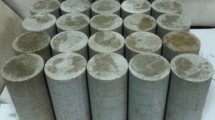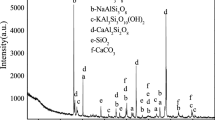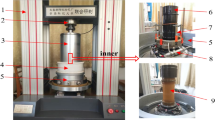Abstract
To reveal the deformation mechanism during tunneling in deep soft ground, triaxial unloading confining pressure tests and triaxial unloading creep tests were carried out on sandy mudstone specimens to study the dilatancy and fracturing behavior of soft rock. In the triaxial unloading confining pressure tests, the stress path and different unloading rates were considered to reflect the unloading characteristics of the excavation methods. The unloading rate effects and the rock damage evolution law are studied. The following conclusions are obtained from the results. Firstly, when the unloading rate is smooth, the peak strengths and deviatoric stress–strain curves under the unloading condition are close to those under the conventional loading condition. Secondly, the post-peak brittle characteristics are more apparent with the increasing unloading rates. Thirdly, the soft rock undergoes five deformation and failure regimes of elasticity, pre-peak unloading damage–dilatancy, post-peak brittle drop, linear strain softening and residual perfect plasticity under quasi-static smooth unloading of mechanized excavation which is mainly focused on in this study. Fourthly, the damage evolution law at the pre-peak damage–dilatancy stage follows an exponential function. Fifthly, during the post-peak stages, multistage microfractures are initiated, propagated and finally coalesced forming a shear-fragmentation band with a certain thickness, accompanied by significant volumetric dilatancy. In the triaxial unloading creep tests, multistep unloading of the confining pressure was applied, while the axial pressure was kept constant. The results show that when the deviatoric stress is larger and the experienced creep time is longer, the unloading effect and creep characteristics become more apparent accompanied with obvious lateral dilatancy, eventually leading to significant creep–dilatancy. The progressive failure with time is caused by the damage accumulating with time-dependent crack expansion, which can be called as ‘time-dependent damage and fracturing’. The reasons for the above evolution process are presented, then the deformation mechanism of soft rock is revealed. The soft rock deformation mainly consists of two parts. One part is the pre-peak damage–dilatancy and post-peak fracture–bulking produced at the excavation unloading instant. The other part is creep–dilatancy caused by time-dependent damage and fracturing in a period of time after excavation. The above-mentioned results of damage, dilatancy and fractures evolution process are in good agreement with the in situ monitoring results and previous studies about the surrounding rock convergence, fracturing and EDZ (excavation damaged zone) development.



































Similar content being viewed by others

References
Liu QS, Huang X, Gong QM et al (2016) Application and development of hard rock TBM and its prospect in China. Tunn Undergr Space Technol 57:33–46
Hoek E, Marinos P (2000) Predicting tunnel squeezing problems in weak heterogeneous rock masses. Tunn Tunn Int 32(11):45–51; 32(12):34–36
Hoek E (2001) Big Tunnels in Bad Rock: The Thirty-Sixth Karl Terzaghi Lecture. J Geotech Geoenviron 127(9):726–740
Barla G (2002). Tunneling under squeezing rock conditions. In: Advances in geotechnical engineering and tunnelling (Kolymbas, D. (ed.)). Berlin: Logos Verlag, pp 169–268
Anagnostou G, Cantieni L (2007) Design and analysis of yielding support in squeezing ground. In: The second half century of rock mechanics, 11th Congress of the International Society for Rock Mechanics (ISRM), Lisbon, vol 2. Taylor & Francis Group, London, pp 829–832
Ramoni M, Anagnostou G (2006) On the feasibility of TBM drives in squeezing ground. Tunn Undergr Space Technol 21(3): 262
Ramoni M, Anagnostou G (2010) Thrust force requirements for TBMs in squeezing ground. Tunn Undergr Space Technol 25(4):433–455
Shalabi FI (2005) FE analysis of time-dependent behavior of tunneling in squeezing ground using two different creep models. Tunnelling Underground Space Technol 20:271–279
Aristorenas GV (1992) Time-dependent behavior of tunnels excavated in shale. Ph. D. Dissertation, Massachusetts Institute of Technology
Ramoni M (2010) On the feasibility of TBM drives in squeezing ground and the risk of shield jamming. Ph. D. Dissertation, ETH Zurich
Aydan Ö, Akagi T, Kawamoto T (1996) The squeezing potential of rocks around tunnels: theory and prediction with examples taken from Japan. Rock Mech Rock Eng 29(3): 125–143.
Malan DF (2002) Simulating the time-dependent behavior of excavations in hard rock. Rock Mech Rock Eng 35(4): 225–254
Kolymbas D, Fellin W, Kirsch A (2006) Squeezing due to stress relaxation in foliated rock. Int J Numer Anal Met 30(13):1357–1367
Gharouni-Nik M, Fathali M (2013) Investigating the effect of dilation on VNL and CNL types shear strength. Int J Civ Eng 11(1):65–70
Qiu SL, Feng XT, Xiao JQ, Zhang CQ (2014) An experimental study on the pre-peak unloading damage evolution of marble. Rock Mech Rock Eng 47(2): 401–419
Li XZ, Shao ZS (2016) Investigation of macroscopic brittle creep failure caused by microcrack growth under step loading and unloading in rocks. Rock Mech Rock Eng 49(7):2581–2593
Martin CD, Kaiser PK, Christiansson R (2003) Stress, instability and design of underground excavations. Int J Rock Mech Min Sci 40(7–8):1027–1047
Huang RQ, Huang D (2014) Evolution of rock cracks under unloading condition. Rock Mech Rock Eng 47(2):453–466
Walton G, Arzúa J, Alejano LR, Diederichs MS (2015) A laboratory-testing-based study on the strength, deformability, and dilatancy of carbonate rocks at low confinement. Rock Mech Rock Eng 48(3):941–958
Dob H, Messast S, Mendjel A et al (2016) Behavior of sand after a high number of cycles application to shallow foundation. Int J Civ Eng 14(7):459–465
Bridgman PW (1950) Volume changes in the plastic stages of simple compression. J Appl Phys 20(12):1241–1251
Zhang K, Zhou H, Shao, JF (2013) An experimental investigation and an elastoplastic constitutive model for a porous rock. Rock Mech Rock Eng 46(6): 1499–1511
Kaiser PK, Yazici S, Maloney S (2001) Mining-induced stress change and consequences of stress path on excavation stability-a case study. Int J Rock Mech Min Sci 38(2):167–180
Cantieni L, Anagnostou G (2009) The effect of the stress path on squeezing behavior in tunneling. Rock Mech Rock Eng 42(2): 289–318
Moghaddas Tafreshi SN, Tavakoli Mehrjardi G, Ahmadi M (2011) Experimental and numerical investigation on circular footing subjected to incremental cyclic loads. Int J Civ Eng 9(4):265–274
Chen J, Jiang DY, Ren S, Yang CH (2016) Comparison of the characteristics of rock salt exposed to loading and unloading of confining pressures. Acta Geotech 11(1):221–230
Borhani A, Fakharian K (2016) Effect of particle shape on dilative behavior and stress path characteristics of chamkhaleh sand in undrained triaxial tests. Int J Civ Eng 14(4):197–208
Eberhardt E (2001) Numerical modelling of three-dimension stress rotation ahead of an advancing tunnel face. Int J Rock Mech Min Sci 38(4):499–518
Martin CD (1997) Seventeenth Canadian Geotechnical Colloquium: The effect of cohesion loss and stress path on brittle rock strength. Can Geotech J 34(5):698–725
Cai M, Kaiser PK (2005) Assessment of excavation damaged zone using a micromechanics model. Tunn Undergr Space Technol 20(4):301–310
Chen HF (2005) Elasticity and Plasticity. China Architecture & Building Press, Beijing
Tran-Manh H, Sulem J, Subrin D (2016) Progressive degradation of rock properties and time-dependent behavior of deep tunnels. Acta Geotech 11(3):693–711
Shao JF, Zhu QZ, Su K (2003) Modeling of creep in rock materials in terms of material degradation. Comput Geotech 30(7):549–555
Zhao YL, Cao P, Wang WJ et al (2009) Viscoelasto-plastic rheological experiment under circular increment step load and unload and nonlinear creep model of soft rocks. J Cent South Univ Technol 16(3):488–494
Debernardi D, Barla G (2009) New viscoplastic model for design analysis of tunnels in squeezing conditions. Rock Mech Rock Eng 42(2): 259–288
Wang GJ, Zhang L, Zhang YW, Ding GS (2014) Experimental investigations of the creep–damage–rupture behavior of rock salt. Int J Rock Mech Min Sci 66(1):181–187
Cai M (2008) Influence of stress path on tunnel excavation response-numerical tool selection and modeling strategy. Tunn Undergr Space Technol 23(6):618–628
Yan P, Lu WB, Chen M, Shan ZG, Chen XR, Zhou Y (2012) Energy release process of surrounding rocks of deep tunnels with two excavation methods. J Rock Mech Geotech Eng 4(2):160–167
Ji F, Lu JF, Shi YC, Zhou CH (2013) Mechanical response of surrounding rock of tunnels constructed with the TBM and drill-blasting method. Nat Hazards 66(2):545–556
Barton NR (2000) TBM tunneling in jointed and faulted rock. Balkema, Rotterdam
Yan P, Lu WB, Chen M et al (2012) Energy release process of surrounding rocks of deep tunnels with two excavation methods. J Rock Mech Geotech 4(2):160–167
Liu J, Li JL, Wang XH, Qu JJ, Zhu T (2009) Study on unloading rock mass constitutive relationship. Advances in Environmental Geotechnics, Proc. of Int Symp on Geoenvironmental Eng, ISGE pp 480–486
Zhang QB, Zhao J (2014) Quasi-static and dynamic fracture behavior of rock materials: phenomena and mechanisms. Int J Fract 189(1):1–32
Ulusay R, Hudson JA (2007) The complete ISRM suggested methods for rock characterization, testing and monitoring: 1974–2006. Compilation arranged by the ISRM Turkish National Group, Ankara, Turkey
Marsden JE, Hughes TJR (1994) Mathematical Foundations of elasticity. Dover Publications, New York
Sharan SK (2008) Analytical solutions for stresses and displacements around a circular opening in a generalized Hoek-Brown rock. Int J Rock Mech Min Sci 40(1):78–85
Zhao XG, Wang J, Cai M et al (2014) Influence of unloading rate on the strainburst characteristics of beishan granite under true-triaxial unloading conditions. Rock Mech Rock Eng 47(2):467–483
Huang RQ, Wang XN, Chan LS (2001) Triaxial unloading test of rocks and its implication for rock burst. Bull Eng Geol Env 60(1): 37–41
Luo CW, Li HB, Liu YQ (2011) Characteristics of in-situ stress and variation law of plastic zone of surrounding rocks around deep tunnels in a coal mine. Chin J Rock Mech Eng 30(8): 1613–1618 (in Chinese)
Liu QS, Liu KD (2012) Characteristics of in-situ stress field for deep levels in Huainan coal mine. Rock Soil Mech 33(7): 2089–2096 (in Chinese)
Wu XY (1996) Stress relaxation, strain hardening and strain softening in rocks. Prog Geophys 11(4): 71–76 (in Chinese)
Zhang K, Zhou H, Pan PZ et al (2010) Characteristics of strength of rocks under different unloading rates. Rock Soil Mech 31(7): 2072–2078 (in Chinese)
Barla G, Debernardi D, Sterpi D (2012) Time-dependent modeling of tunnels in squeezing conditions. Int J Geomech 12(6):697–710
Barla G, Barla M, Bonini M, Debernardi D (2014) Guidelines for TBM tunneling in squeezing conditions—a case study. Geotech Lett 4: 83–87
Cao P, Wen YD, Wang YX et al (2016) Study on nonlinear damage creep constitutive model for high-stress soft rock. Environ. Earth Sci 75(10):1–8. doi:10.1007/s12665-016-5699-x
Kachanov LM (1986) Introduction to continuum damage mechanics, Martinus Nijhoff Publishers
Bonini M, Debernardi D, Barla M, Barla G (2009) The mechanical behavior of clay shales and implications on the design of tunnels. Rock Mech Rock Eng 42(2): 361–388
Sterpi D, Gioda G (2009) Visco-plastic behavior around advancing tunnels in squeezing rock. Rock Mech Rock Eng 42(2): 319–339
Hasanpour R, Rostami J, Ünver B (2014) 3D finite difference model for simulation of double shield TBM tunneling in squeezing grounds. Tunn Undergr Space Technol 40(2):109–126
Zhao K, Janutolo M, Barla G (2012) A completely 3D model simulation of mechanized tunnel excavation. Rock Mech Rock Eng 45(4): 475–497
Zhao K, Mariacristina B, Debernardi D, Janutolo M, Barla G et al (2015) Computational modelling of the mechanised excavation of deep tunnels in weak rock. Comput Geotech 66:158–171
Munjiza A (2004) The Combined Finite-Discrete Element Method. John Wiley & Sons Ltd, London
Shi GH (1991) Manifold method of material analysis. Paper presented at the Trans 9th Army conference on applied mathematics and computing, Minneaplolis: Minesota
Li SJ, Feng XT, Li ZH et al (2011) In situ experiments on width and evolution characteristics of excavation damaged zone in deeply buried tunnels. Sci China 54(S1): 167–174.
Li SJ, Feng XT, Li ZH et al (2012) Evolution of fractures in the excavation damaged zone of a deeply buried tunnel during TBM construction. Int J Rock Mech Min Sci 55:125–138
Chen BR, Feng XT, Xiao YX et al (2010) Acoustic emission test on damage evolution of surrounding rock in deep-buried tunnel during TBM excavation. Chin J Rock Mech Eng 29(8): 1562–1569 (in Chinese)
Acknowledgements
This work was financially supported by the National Basic Research Program of China (‘973’ Program, grant No. 2014CB046904 and No. 2015CB058102) and the National Natural Science Foundation of China (Grant No. 41602326). Their support is gratefully acknowledged.
Author information
Authors and Affiliations
Corresponding author
Rights and permissions
About this article
Cite this article
Huang, X., Liu, Q., Liu, B. et al. Experimental Study on the Dilatancy and Fracturing Behavior of Soft Rock Under Unloading Conditions. Int J Civ Eng 15, 921–948 (2017). https://doi.org/10.1007/s40999-016-0144-9
Received:
Revised:
Accepted:
Published:
Issue Date:
DOI: https://doi.org/10.1007/s40999-016-0144-9



